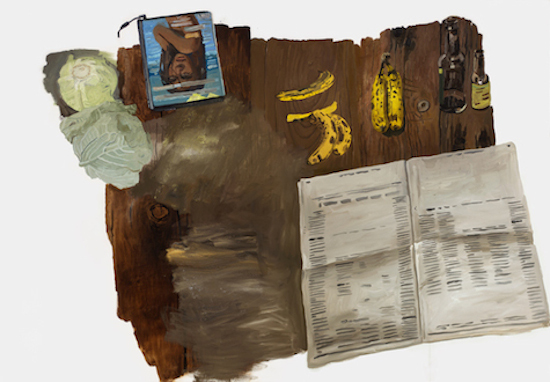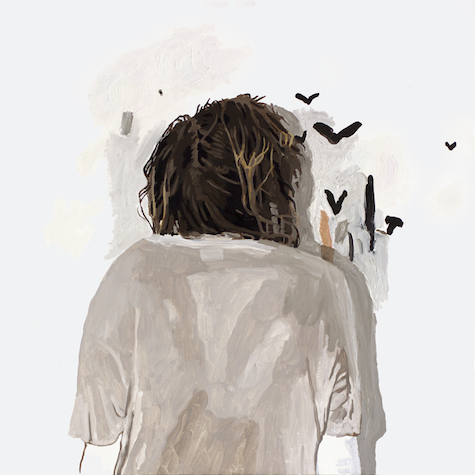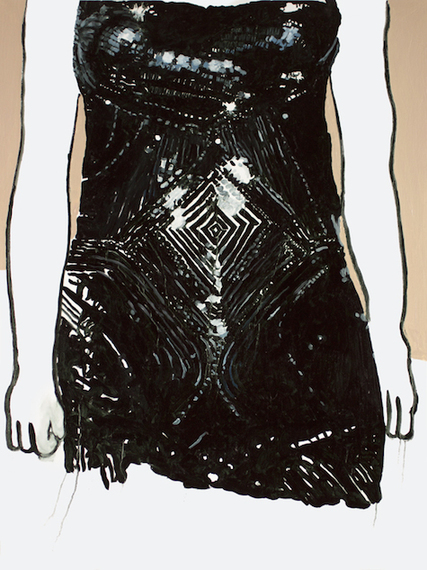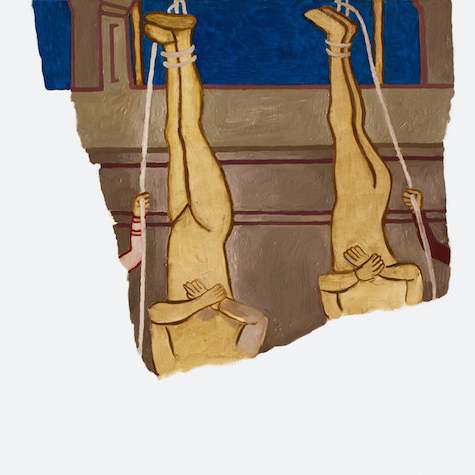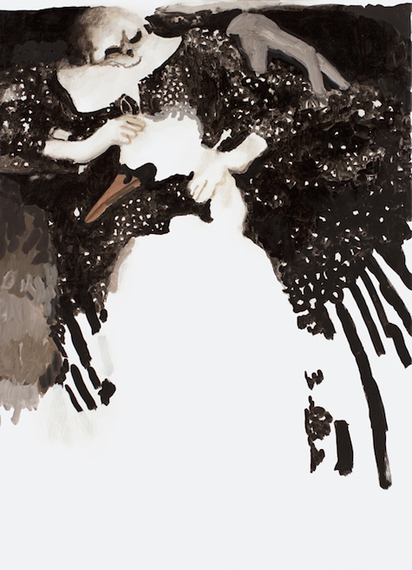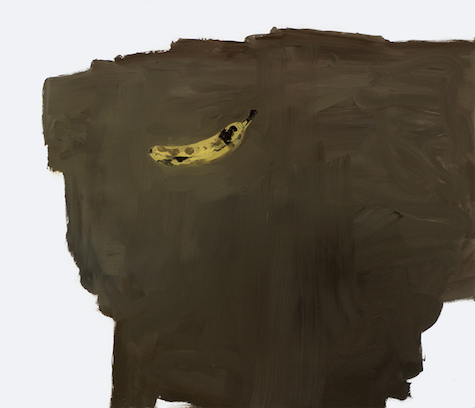When I walked into Margaux Williamson's show, I Could See Everything at Mulherin + Pollard gallery on the Lower East Side, I thought I knew what to expect. After all, I had been given the privilege of a sneak peek of sorts over brunch in Prospect Heights with Margaux and my girlfriend a few weeks prior.
We spent that brunch and some time after passing the printed proofs for Margaux's work across the table like trading cards -- she was putting together an exhibition catalogue you can pick up at the gallery or online. My girlfriend exclaimed over the titles while I exclaimed over the technique as we played with different pairings of her paintings.
Margaux is a generous conversationalist. She's the kind of creative friend that makes me regret the years I didn't know her yet.
By the time we sent Margaux on her way with more ornate than helpful directions back to the Lower East Side, I felt like I knew something more about her work.
And I did. I knew that she was a painter who also makes films and who like me has a relationship with early morning that we wish we could tweak a bit. I knew that her work explored the domestic, the not yet happened, the spaces in between still life and pop culture movements. I knew that she worked in isolated parts of the world. I had a clear favorite. I'll keep that between Margaux and me for now.
Walking into the gallery, which allows for close inspection even during a high-energy opening like Margaux's, I was struck by the textures, the sparkly quality, and the light. The titles were scrawled in pencil on the walls beside the works. It was a perfect illustration of Margaux at play in the realm of fictional painter. And below, some words from the actual painter herself.
> Fictional painter -- why?
I made a movie and started to understand from that process how to connect the dots better. Painting is so fundamentally abstract -- I am so fundamentally abstract.
I noticed that during the day, with the sun on my canvases, I was trying to paint what is hard or impossible or great about the night, and at night, I was painting the reassuringly real things that were around me -- things that are hard to see at night. I made the painting "Painter", which is of the back of my head in front of a canvas, when I was thinking of this - how ugly and bright and humble the day can be, there when reaching for so much more depth. Of course, all those things aren't isolated in our minds, but painting is a good place to see what it looks like -- to see what the rules may be for tying those things together.
> Are you an optimist or a pessimist?
I am a depressive, willful optimist.
> You work and live outside of New York City -- does that distance factor into your life as an artist or your work?
Maybe it makes me more interested or reliant on the Internet, in literature, in communicating over email, in movies, in physically accessible mediums. Maybe if I lived here in New York I would be more engaged in and fulfilled by the live-theatre show of painting. Maybe would be the same, I don't know, but being farther away, I have a hunger to see how everything fits together, to understand the main ideas that stand out with work I love across all mediums, how culture is connecting with people outside the centers of culture, what people are trying to do with different mediums, what they are trying to say, who they are talking to.
Probably in a lot of ways it's a challenge, but it is also probably a gift to be in a place where no one's really paying attention to what kind of financial or critical success you're getting -- that space can offer a lot of good silence. Being where I am, or who I am, the only measure of success that seems real to me is in colleagues (from New York or Toronto or Thunder Bay -- from critics to artists to poets) whose work I love who are engaged with my work. It always feels patient and equal, I am fortunate for that.
> Is travel important to your practice?
Not really. I crave isolation sometimes, and sometimes I crave longstanding conversations with amazing people. I guess those different desires create a need to move around. In my second floor apartment in Toronto, over a shop, the front faces a busy street in a lively neighborhood where lots of people I know are always around. The back of the apartment is sort of this add on cottage-like looking structure that leads to the rooftops, there are trees in buckets there and it's always so quiet. I try to imagine that that is enough for all your city and country needs, but I often have a longing to head 10 hours north to the woods or 10 hours south to New York City.
> How do you come up with your titles? Are they meant to serve as clues or creative offerings unto themselves?
Sometimes I would make a painting and I would think for instance, that looks like we made a new justice archway. Then I would throw out the first painting and put that title on a new image that would open up that title in a more meaningful way than an illustrative way. So, all the titles happened pretty organically. The titles were intuitive clues to myself, on where I was going, more than clues to others. At one point, I typed all the titles I was working with and put them on the wall to look at them. This sounds funny to say, but it wasn't till I had about 60 titles that I even realized they were all led by "I" or "We" and the rarer "Us".
> What is the role of the readymade; of pop culture in your work?
I think of Marcel Duchamp a lot in terms of time management. I like how he was kind of lazy and thought really hard about how to move around less. I've learned to slow down and spend more time playing in my mind and less time using my hands. It's a pleasure, a better game.
Painting is such a medium of construction and rearrangement. I thought here to take advantage of that, to construct and rearrange the world, to take advantage of painting. But half way through making this series, once I had this framework already set, my more fundamental nature took over, the one that relates more to the world in front of me than to utopias or fantasies. I placed this new framework back on that view.
So when I came across this old 14th century Christian painting in a special edition magazine about the new Pope, I saw that image and thought, "We built a new justice archway". I barely changed the image at all. I could have just taken the picture from the magazine and put it on the wall, but I really wanted to show the sincere attempt at moving your hands in service of trying to see things more clearly or trying to help make a new world -- even if you don't have much of an imagination for one.
I find it one of the greatest pleasures in art -- when the view doesn't change in the slightest but everything looks completely different.
> What's your favorite season?
I feel most excited when the seasons change. I somehow never think of the past or future, so when suddenly the air is warmer and the leaves start to go, I always feel so surprised.
> What was your favorite age -- is it represented in your painting?
I like the present time the best. I would be so lonely to go back to another time, like not having your own face anymore. I am good at seeing the value of what is around me -- the beautiful limitations of one's time or one's face.
> There seems to be a tension between the tamed and untamed -- whether it's landscape or personal terrain -- is there any resolution beyond resigned co-existence?
Good point.
See Margaux Williamson's show I Could See Everything at Mulherin + Pollard in New York City through May 25, 2014.
All images courtesy Margaux Williamson
